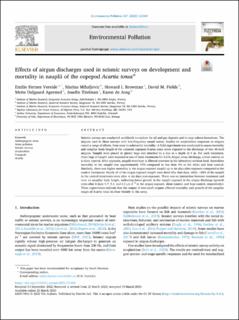| dc.contributor.author | Vereide, Emilie Hernes | |
| dc.contributor.author | Mihaljevic, Marina | |
| dc.contributor.author | Browman, Howard | |
| dc.contributor.author | Fields, David M. | |
| dc.contributor.author | Agersted, Mette Dalgaard | |
| dc.contributor.author | Titelman, Josefin | |
| dc.contributor.author | Jong, Karen de | |
| dc.date.accessioned | 2023-10-03T08:23:49Z | |
| dc.date.available | 2023-10-03T08:23:49Z | |
| dc.date.created | 2023-04-25T10:32:35Z | |
| dc.date.issued | 2023 | |
| dc.identifier.citation | Environmental Pollution. 2023, 327 . | |
| dc.identifier.issn | 1566-0745 | |
| dc.identifier.uri | https://hdl.handle.net/11250/3093674 | |
| dc.description.abstract | Seismic surveys are conducted worldwide to explore for oil and gas deposits and to map subsea formations. The airguns used in these surveys emit low-frequency sound waves. Studies on zooplankton responses to airguns report a range of effects, from none to substantial mortality. A field experiment was conducted to assess mortality and naupliar body length of the calanoid copepod Acartia tonsa when exposed to the discharge of two 40-inch airguns. Nauplii were placed in plastic bags and attached to a line at a depth of 6 m. For each treatment, three bags of nauplii were exposed to one of three treatments for 2.5 h: Airgun array discharge, a boat control, or a silent control. After exposure, nauplii were kept in filtered seawater in the laboratory without food. Immediate mortality in the nauplii was approximately 14% compared to less than 4% in the silent and boat control. Similarly, there was higher mortality in the airgun exposed nauplii up to six days after exposure compared to the control treatments. Nearly all of the airgun exposed nauplii were dead after four days, while >50% of the nauplii in the control treatments were alive at six days post-exposure. There was an interaction between treatment and time on naupliar body length, indicating lower growth in the nauplii exposed to the airgun discharge (growth rates after 4 days: 1.7, 5.4, and 6.1 μm d−1 in the airgun exposed, silent control, and boat control, respectively). These experiments indicate that the output of two small airguns affected mortality and growth of the naupliar stages of Acartia tonsa in close vicinity to the array. | |
| dc.language.iso | eng | |
| dc.title | Effects of airgun discharges used in seismic surveys on development and mortality in nauplii of the copepod Acartia tonsa | |
| dc.title.alternative | Effects of airgun discharges used in seismic surveys on development and mortality in nauplii of the copepod Acartia tonsa | |
| dc.type | Peer reviewed | |
| dc.type | Journal article | |
| dc.description.version | publishedVersion | |
| dc.source.pagenumber | 9 | |
| dc.source.volume | 327 | |
| dc.source.journal | Environmental Pollution | |
| dc.identifier.doi | 10.1016/j.envpol.2023.121469 | |
| dc.identifier.cristin | 2143137 | |
| dc.relation.project | Norges forskningsråd: 302675 | |
| dc.relation.project | Norges forskningsråd: 280367 | |
| cristin.ispublished | true | |
| cristin.fulltext | original | |
| cristin.qualitycode | 1 | |
